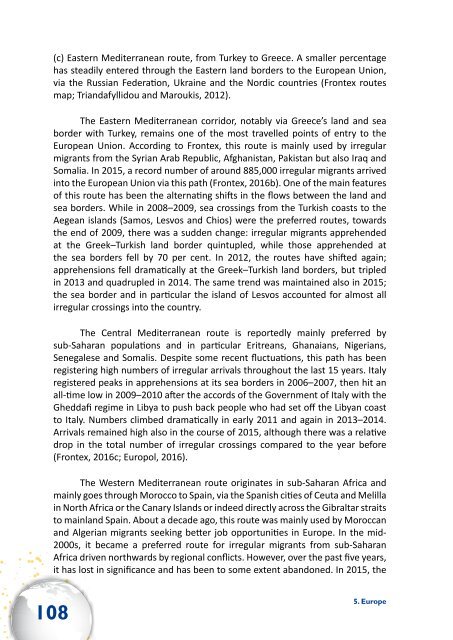Migrant Smuggling Data and Research
zgw9fv2
zgw9fv2
You also want an ePaper? Increase the reach of your titles
YUMPU automatically turns print PDFs into web optimized ePapers that Google loves.
(c) Eastern Mediterranean route, from Turkey to Greece. A smaller percentage<br />
has steadily entered through the Eastern l<strong>and</strong> borders to the European Union,<br />
via the Russian Federation, Ukraine <strong>and</strong> the Nordic countries (Frontex routes<br />
map; Tri<strong>and</strong>afyllidou <strong>and</strong> Maroukis, 2012).<br />
The Eastern Mediterranean corridor, notably via Greece’s l<strong>and</strong> <strong>and</strong> sea<br />
border with Turkey, remains one of the most travelled points of entry to the<br />
European Union. According to Frontex, this route is mainly used by irregular<br />
migrants from the Syrian Arab Republic, Afghanistan, Pakistan but also Iraq <strong>and</strong><br />
Somalia. In 2015, a record number of around 885,000 irregular migrants arrived<br />
into the European Union via this path (Frontex, 2016b). One of the main features<br />
of this route has been the alternating shifts in the flows between the l<strong>and</strong> <strong>and</strong><br />
sea borders. While in 2008–2009, sea crossings from the Turkish coasts to the<br />
Aegean isl<strong>and</strong>s (Samos, Lesvos <strong>and</strong> Chios) were the preferred routes, towards<br />
the end of 2009, there was a sudden change: irregular migrants apprehended<br />
at the Greek–Turkish l<strong>and</strong> border quintupled, while those apprehended at<br />
the sea borders fell by 70 per cent. In 2012, the routes have shifted again;<br />
apprehensions fell dramatically at the Greek–Turkish l<strong>and</strong> borders, but tripled<br />
in 2013 <strong>and</strong> quadrupled in 2014. The same trend was maintained also in 2015;<br />
the sea border <strong>and</strong> in particular the isl<strong>and</strong> of Lesvos accounted for almost all<br />
irregular crossings into the country.<br />
The Central Mediterranean route is reportedly mainly preferred by<br />
sub-Saharan populations <strong>and</strong> in particular Eritreans, Ghanaians, Nigerians,<br />
Senegalese <strong>and</strong> Somalis. Despite some recent fluctuations, this path has been<br />
registering high numbers of irregular arrivals throughout the last 15 years. Italy<br />
registered peaks in apprehensions at its sea borders in 2006–2007, then hit an<br />
all-time low in 2009–2010 after the accords of the Government of Italy with the<br />
Gheddafi regime in Libya to push back people who had set off the Libyan coast<br />
to Italy. Numbers climbed dramatically in early 2011 <strong>and</strong> again in 2013–2014.<br />
Arrivals remained high also in the course of 2015, although there was a relative<br />
drop in the total number of irregular crossings compared to the year before<br />
(Frontex, 2016c; Europol, 2016).<br />
The Western Mediterranean route originates in sub-Saharan Africa <strong>and</strong><br />
mainly goes through Morocco to Spain, via the Spanish cities of Ceuta <strong>and</strong> Melilla<br />
in North Africa or the Canary Isl<strong>and</strong>s or indeed directly across the Gibraltar straits<br />
to mainl<strong>and</strong> Spain. About a decade ago, this route was mainly used by Moroccan<br />
<strong>and</strong> Algerian migrants seeking better job opportunities in Europe. In the mid-<br />
2000s, it became a preferred route for irregular migrants from sub-Saharan<br />
Africa driven northwards by regional conflicts. However, over the past five years,<br />
it has lost in significance <strong>and</strong> has been to some extent ab<strong>and</strong>oned. In 2015, the<br />
108<br />
5. Europe
















